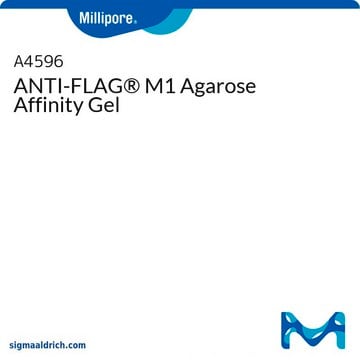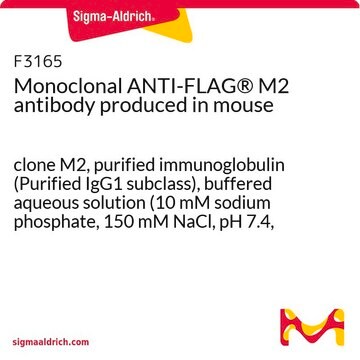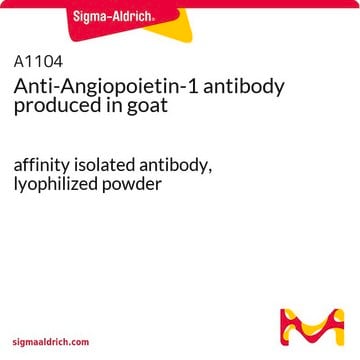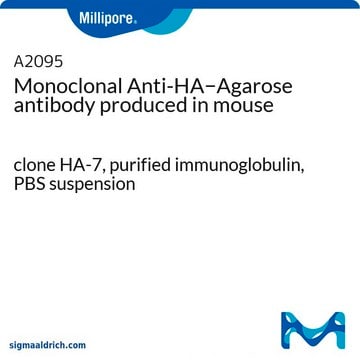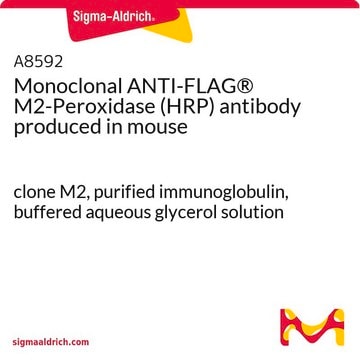The "1mL" indicates that this product is supplied at a volume of 1 milliliter. This ANTI-FLAG M2 affinity gel is supplied as a 50% suspension in 50% glycerol with 10 mM sodium phosphate and 150 mM sodium chloride, pH 7.4, containing 0.02% (w/v) sodium azide (PBS/A).
A2220
Gel d'affinité ANTI-FLAG® M2
purified immunoglobulin, buffered aqueous glycerol solution
Synonyme(s) :
Anticorps monoclonal ANTI-FLAG® M2 antibody produced in mouse, Gel d'agarose pour chromatographie d'affinité ANTI-FLAG® M2, Anti-ddddk, Anti-dykddddk
Sélectionner une taille de conditionnement
Sélectionner une taille de conditionnement
About This Item
affinity chromatography
immunoprecipitation (IP): suitable
Produits recommandés
Conjugué
agarose conjugate
Niveau de qualité
Forme d'anticorps
purified immunoglobulin
Type de produit anticorps
primary antibodies
Clone
M2, monoclonal
Forme
buffered aqueous glycerol solution
Classe(s) chimique(s) de l'analyte
proteins
Technique(s)
affinity chromatography: suitable
immunoprecipitation (IP): suitable
Matrice
(4% agarose bead; 45-165μm bead size)
Isotype
IgG1
Capacité
>0.6 mg/mL, resin binding capacity (FLAG-BAP)
Conditions d'expédition
wet ice
Température de stockage
−20°C
Vous recherchez des produits similaires ? Visite Guide de comparaison des produits
Description générale
Élution - peptide FLAG®, glycine, pH 3,5, 3x peptide FLAG®
Immunogène
Application
Pour en savoir plus sur nos produits, rendez-vous sur notre portail des applications des produits FLAG®.
Forme physique
Autres remarques
Informations légales
Clause de non-responsabilité
Vous ne trouvez pas le bon produit ?
Essayez notre Outil de sélection de produits.
Produit(s) apparenté(s)
Souvent commandé avec ce produit
Code de la classe de stockage
10 - Combustible liquids
Classe de danger pour l'eau (WGK)
WGK 1
Point d'éclair (°F)
Not applicable
Point d'éclair (°C)
Not applicable
Faites votre choix parmi les versions les plus récentes :
Certificats d'analyse (COA)
Vous ne trouvez pas la bonne version ?
Si vous avez besoin d'une version particulière, vous pouvez rechercher un certificat spécifique par le numéro de lot.
Déjà en possession de ce produit ?
Retrouvez la documentation relative aux produits que vous avez récemment achetés dans la Bibliothèque de documents.
Les clients ont également consulté
Articles
The FLAG® Expression System is a proven method to express, purify and detect recombinant fusion proteins. Sigma®, the proven provider of FLAG®, now offers a magnetic bead for immunoprecipitation, protein purification, and the study of protein-protein interactions. The ANTI-FLAG® M2 Magnetic Bead is composed of murine derived, anti-FLAG® M2 monoclonal antibody attached to superparamagnetic iron impregated 4% agarose beads, with an average diameter of 50 µm. The M2 antibody is capable of binding to fusion proteins containing a FLAG peptide sequence at the N-terminus, Met-N-terminus, or C-terminus locations in mammalian, bacterial, and plant extracts.
Protocoles
Protocol for immunoprecipitation (IP) of FLAG fusion proteins using M2 monoclonal antibody 4% agarose affinity gels
Contenu apparenté
Techniques, réactifs et protocoles permettant de purifier les protéines recombinantes par différentes méthodes telles que la chromatographie d'échange d'ions, la chromatographie d'exclusion stérique ou la chromatographie d'affinité.
Protein purification techniques, reagents, and protocols for purifying recombinant proteins using methods including, ion-exchange, size-exclusion, and protein affinity chromatography.
-
May I ask a question about the product? Does "1mL" mean 1 mL Slurry plus 50% glycerol, which is 2 mL in total? Same as other (e.g., 10 mL = 50% slurry with total 20 mL volume)
1 answer-
Helpful?
-
-
What is the bead size for this product?
1 answer-
As stated in the 'PROPERTIES' section of the product page, the bead size range is 45-165 μm.
Helpful?
-
-
Is there a generic agarose bead available for purchase that can be used as a control to test for non-specific binding, in the case that something is binding to the agarose bead itself rather than the tag? If it is not listed on the site, is there a possibility of obtaining generic agarose beads through alternative means? Alternatively, could any information be provided to determine if another provider's generic agarose beads are produced in a similar manner for this specific purpose?
1 answer-
Yes, there are two options available for a generic agarose bead as a control to test for non-specific binding. One option is Product Number. 4B200, Sepharose® 4B, which can be used for sample preclearing and is equivalent to the beads in the FLAG affinity product. The other option is Product Number: A0919, Mouse IgG−Agarose, which can serve as a conjugated antibody bead control.
Helpful?
-
-
Is there a protocol for regeneration?
1 answer-
Please see the link below to the product data-sheet. Instructions state that the column should be regenerated immediately after use by washing with three column volumes of 0.1 M glycine HCI, pH 3.5. The column should be immediately re-equilibrated in TBS until the effluent is at neutral pH:
https://www.sigmaaldrich.com/deepweb/assets/sigmaaldrich/product/documents/288/183/a2220bul-ms.pdf
Helpful?
-
-
When using ANTI-FLAG M2 Affinity Gel, Product A2220, should I use a 3X FLAG peptide or a 1X FLAG peptide to elute my protein?
1 answer-
If you have a 3X FLAG-tagged protein, then you will need to use the 3X FLAG peptide. If you have a 1X FLAG-tagged protein, you can use the 1X FLAG peptide or the 3X FLAG peptide. We have not noticed a significant difference in elution efficiency by using a 3X FLAG peptide on a 1X FLAG-tagged protein.
Helpful?
-
-
How should I elute my protein when using Product No. A2220, ANTI-FLAG® M2 Affinity Gel?
1 answer-
Elution with the peptide is the most gentle method. Acid elution (0.1 M glycine-HCL pH 3.5) is a more stringent method of elution, and should be evaluated for its effect on your protein if it is to be used in downstream applications. Boiling the resin in sample buffer is the most denaturing condition. If this condition is used, the resin cannot be re-used, due to the presence of SDS and/or reducing agents. The elution information can be viewed on A2220 product information sheet (under Documents, above).
Helpful?
-
-
I am using Product No. A2220, ANTI-FLAG® M2 Affinity Gel, and have a lot of non-specific proteins that are eluting with my FLAG®-tagged protein. How can I get rid of these?
1 answer-
The product bulletin for Product A2220, ANTI-FLAG® M2 affinity gel indicates:Pre-clear lysate with Mouse IgG-Agarose (Product A0919) to remove nonspecific binding proteins. Alternatively, you can use the unconjugated resin (Product 4B200) for this purpose. Other methods to remove non-specific binding from the resin would be to increase the stringency of the washes by increasing salt concentration (the resin can tolerate up to 1M NaCl) or including detergents that are compatible with the resin.
Helpful?
-
-
When using Product No. A2220, ANTI-FLAG® M2 Affinity Gel, I see bands at 20-25 kDa and 50-60 kDa appearing in my Westerns that are not my FLAG®-tagged protein. How can I prevent this?
1 answer-
As a result of the conjugation, there may be some M2 antibody that is not conjugated to the resin, but is associated with the resin and may appear in acid elutions as heavy and light chain when using the anti-mouse IgG conjugated secondary antibody. We recommend an acid wash (0.1 M glycine-HCL pH 3.5) and neutralization of the resin (do not allow the acid wash to sit on the resin longer than 20 minutes) prior to applying the lysate. Another way to avoid this is to use a directly conjugated FLAG® antibody for detection such as product A8592 ANTI-FLAG® M2 HRP, or the rabbit anti-FLAG® polyclonal antibody, F7425.
Helpful?
-
-
What is the Department of Transportation shipping information for this product?
1 answer-
Transportation information can be found in Section 14 of the product's (M)SDS.To access the shipping information for this material, use the link on the product detail page for the product.
Helpful?
-
-
Is my lysis buffer compatible with Product No. A2220, ANTI-FLAG® M2 Affinity Gel?
1 answer-
The A2220 product information sheet (under Documents, above) contains a reagent compatibility table located on page 6. We do not recommend addition of SDS or reducing agents such as DTT, DTE or 2-mercaptoethanol to the resin. If you have a detergent listed in the table in a higher than recommended concentration, we recommend trying to dilute the sample before applying to the resin.
Helpful?
-
Active Filters
Notre équipe de scientifiques dispose d'une expérience dans tous les secteurs de la recherche, notamment en sciences de la vie, science des matériaux, synthèse chimique, chromatographie, analyse et dans de nombreux autres domaines..
Contacter notre Service technique




